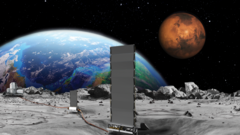NASA has announced an expedited initiative to establish a nuclear reactor on the Moon by 2030, amidst escalating global interest in lunar exploration. As reported by US media, the project aims to facilitate the creation of a permanent human settlement on the lunar surface. The acting head of NASA pointed out that competing efforts from nations like China and Russia may provoke these countries to assert territorial claims, potentially establishing restricted zones on the Moon.
Despite NASA’s aspirations, the feasibility of meeting this deadline is uncertain due to significant budget constraints recently enforced on the agency, which could hinder both development and technological advancement. Experts have expressed concerns that the urgency behind this initiative may be influenced more by geopolitical strategy than by pure scientific intent. Various nations, including the US, China, Russia, India, and Japan, are making strides towards lunar exploration, each with intentions of creating sustainable human habitats.
Transport Secretary Sean Duffy, appointed by former President Trump to lead NASA temporarily, highlighted the need for commercial partnerships to develop a nuclear reactor capable of generating at least 100 kilowatts of power. While this quantity is modest compared to conventional energy solutions, it is viewed as necessary for supporting operations on the Moon where sustaining power is challenging due to extended periods of daylight and darkness. The concept of lunar nuclear reactors is not novel; previous contracts have been issued by NASA to design such systems.
On the other hand, China and Russia have set their sights on establishing automated nuclear power stations on the Moon by 2035, which many scientists assert is crucial for sustained lunar operations. They argue that solar power would be insufficient given the Moon's two-week cycles of sunlight followed by two weeks of darkness.
Experts like Dr. Simeon Barber have raised concerns about the safety of launching radioactive materials into space, although he believes safety regulations could be effectively addressed. Meanwhile, funding uncertainties following a 24% cut to NASA's budget in 2026 could stunt major projects, such as the ambitious Mars Sample Return endeavor.
Critics emphasize that if the nuclear reactor initiative reflects a revival of Cold War-era space racing, it might hinder broader scientific objectives in space exploration. Dr. Barber underlined that competition, while fostering innovation, should not overshadow the ultimate goal of advancing our understanding of the solar system.
The discussions surrounding the plans intersect with the Artemis Accords, an agreement between several nations about responsible lunar exploration and operational safety. However, establishing a nuclear reactor raises complex questions regarding territorial claims that could restrict access and collaboration among nations.
While the timeline for achieving lunar nuclear capability remains ambitious, experts emphasize that securing reliable transportation and logistical infrastructure for equipment and personnel is equally essential for realizing NASA's broader goals for lunar exploration.
Despite NASA’s aspirations, the feasibility of meeting this deadline is uncertain due to significant budget constraints recently enforced on the agency, which could hinder both development and technological advancement. Experts have expressed concerns that the urgency behind this initiative may be influenced more by geopolitical strategy than by pure scientific intent. Various nations, including the US, China, Russia, India, and Japan, are making strides towards lunar exploration, each with intentions of creating sustainable human habitats.
Transport Secretary Sean Duffy, appointed by former President Trump to lead NASA temporarily, highlighted the need for commercial partnerships to develop a nuclear reactor capable of generating at least 100 kilowatts of power. While this quantity is modest compared to conventional energy solutions, it is viewed as necessary for supporting operations on the Moon where sustaining power is challenging due to extended periods of daylight and darkness. The concept of lunar nuclear reactors is not novel; previous contracts have been issued by NASA to design such systems.
On the other hand, China and Russia have set their sights on establishing automated nuclear power stations on the Moon by 2035, which many scientists assert is crucial for sustained lunar operations. They argue that solar power would be insufficient given the Moon's two-week cycles of sunlight followed by two weeks of darkness.
Experts like Dr. Simeon Barber have raised concerns about the safety of launching radioactive materials into space, although he believes safety regulations could be effectively addressed. Meanwhile, funding uncertainties following a 24% cut to NASA's budget in 2026 could stunt major projects, such as the ambitious Mars Sample Return endeavor.
Critics emphasize that if the nuclear reactor initiative reflects a revival of Cold War-era space racing, it might hinder broader scientific objectives in space exploration. Dr. Barber underlined that competition, while fostering innovation, should not overshadow the ultimate goal of advancing our understanding of the solar system.
The discussions surrounding the plans intersect with the Artemis Accords, an agreement between several nations about responsible lunar exploration and operational safety. However, establishing a nuclear reactor raises complex questions regarding territorial claims that could restrict access and collaboration among nations.
While the timeline for achieving lunar nuclear capability remains ambitious, experts emphasize that securing reliable transportation and logistical infrastructure for equipment and personnel is equally essential for realizing NASA's broader goals for lunar exploration.


















